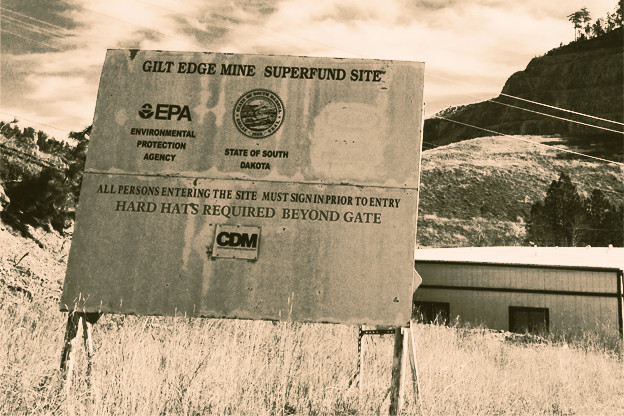

How do you drown-proof a mine? Part 2, a reprise
This is a follow-up story on the Gilt Edge Superfund story. It was originally published on October 30, 2015.
– o O o –
It’s still the question on everyone’s lips
This is a follow-up story; you can read Part 1 here. And you should.
After touring the Gilt Edge Mine with Governor Dayton, DNR Commissioner Tom Landwehr said, Boy, we need a bankruptcy-proof reclamation plan for PolyMet. Or words to that effect.
DNR commissioner Landwehr says legacy issues of mines require a bankruptcy-proof reclamation plan for Polymet pic.twitter.com/sLX3Kbp3ug
— John Croman (@JohnCroman) October 27, 2015
Amen, Commissioner, amen. Incidentally, “legacy issues” is a euphemism for “toxic sulfides” or “pollution.”
But saying it and getting it are two entirely different things. I suggested a few things in Part 1 that ought to be part of any reclamation plan: 1) a guaranty of PolyMet’s environmental obligations by its effective parent, Glencore, PLC.; 2) a first lien for those obligations in favor of the state on all of PolyMet’s assets; and 3) liquid asset reserves adequate to pay potential damage claims of the state and third parties.
But now, I am about to reveal the best idea yet for helping make sure that the state’s taxpayers and citizens have some protection: the IRRRB ought to put the entire Doug Fund up as surety of PolyMet’s performance of its environmental responsibilities.
Perfect, isn’t it? The present balance in the Doug Fund is close to half of what yesterday’s Spotty™ winners say is required to assure mine maintenance after closing (although it doesn’t include anything for cleaning up of a major disaster, which also needs to be accounted for).
I think it’s a wonderful Put your money where you mouth is, Rangers, idea.
For the uninitiated, the Doug Fund is actually the Douglas J. Johnson Economic Protection Trust Fund, named after the long-serving, log-rolling Senate tax chair, Doug Johnson. Doug’s a lobbyist for, inter alia, mining companies now, of course.
First of all it, it isn’t a trust fund, because the people who administer it, the IRRRB, are not trustees in any sense of word. They’re entrenched and elected politicians, virtual Emirs of Northern Minnesota, patronage peddlers, not servants.
The Doug Fund is one of a half dozen funds that the IRRRB controls. It gets its money, as all the IRRRB funds do, from mining production taxes.
Instead of the taxes that ordinary mortals pay, or even ordinary corporations, the mining companies pay occupation and production taxes. The occupation tax is in lieu of the corporate income tax, and it doesn’t bring in all that much money. The production tax is the bonanza, paid in lieu of property taxes — theoretically — and it brings in a lot of money, a portion of which is diverted to the Emirs at the IRRRB.
Believe me, it is great to be an Emir. There is a fantastic amount of ring kissing that goes on. (Some other thing kissing, too.) The IRRRB is a nifty little fiefdom that most people know little about.
All you have to do is fiddle with the per ton percentages a little bit, and the occupation tax gets a lot fatter, and the production tax less so. The tax committees in the Lege are the gates through which legislation to control the rates pass through.
Perhaps you are beginning to understand why it is named the Doug Fund.
Anyway, the Doug Fund has salted away about a hundred and fifty million effing dollars. One. Five. Zero. Million. Effing. Dollars. The Emirs are scared as hell that the Legislature is going to figure this scam out and conduct a de-Emirization of the entire enterprise.
The Doug Fund would be a great place to start.
If PolyMet and its 300 probably non-union jobs (Glencore hates unions; just ask the Steelworkers: Tommy Rukavina’s old union, by the way) are such a great deal for the state, put your Doug Fund chips on the table, IRRRB. It would prove to the rest of us that you’re willing to put some skin in the game.
I have some more about performance bonds, suretyship, and insurance, but that will have to wait for the next installment.
Thanks for your feedback. If we like what you have to say, it may appear in a future post of reader reactions.

